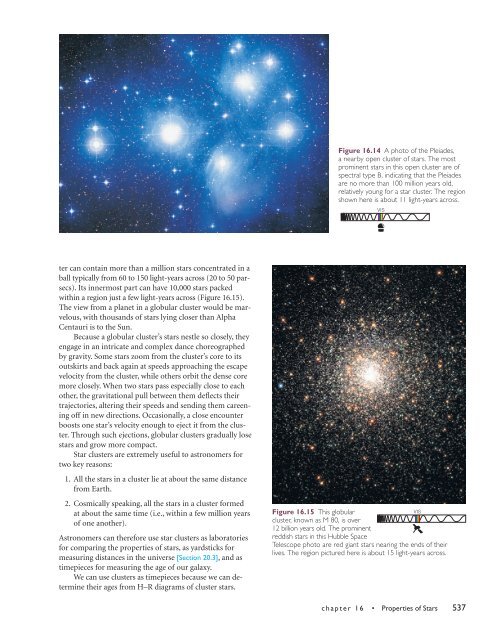Chapter 16--Properties of Stars
Chapter 16--Properties of Stars
Chapter 16--Properties of Stars
You also want an ePaper? Increase the reach of your titles
YUMPU automatically turns print PDFs into web optimized ePapers that Google loves.
ter can contain more than a million stars concentrated in a<br />
ball typically from 60 to 150 light-years across (20 to 50 parsecs).<br />
Its innermost part can have 10,000 stars packed<br />
within a region just a few light-years across (Figure <strong>16</strong>.15).<br />
The view from a planet in a globular cluster would be marvelous,<br />
with thousands <strong>of</strong> stars lying closer than Alpha<br />
Centauri is to the Sun.<br />
Because a globular cluster’s stars nestle so closely, they<br />
engage in an intricate and complex dance choreographed<br />
by gravity. Some stars zoom from the cluster’s core to its<br />
outskirts and back again at speeds approaching the escape<br />
velocity from the cluster, while others orbit the dense core<br />
more closely. When two stars pass especially close to each<br />
other, the gravitational pull between them deflects their<br />
trajectories, altering their speeds and sending them careening<br />
<strong>of</strong>f in new directions. Occasionally, a close encounter<br />
boosts one star’s velocity enough to eject it from the cluster.<br />
Through such ejections, globular clusters gradually lose<br />
stars and grow more compact.<br />
Star clusters are extremely useful to astronomers for<br />
two key reasons:<br />
1. All the stars in a cluster lie at about the same distance<br />
from Earth.<br />
2. Cosmically speaking, all the stars in a cluster formed<br />
at about the same time (i.e., within a few million years<br />
<strong>of</strong> one another).<br />
Astronomers can therefore use star clusters as laboratories<br />
for comparing the properties <strong>of</strong> stars, as yardsticks for<br />
measuring distances in the universe [Section 20.3], and as<br />
timepieces for measuring the age <strong>of</strong> our galaxy.<br />
We can use clusters as timepieces because we can determine<br />
their ages from H–R diagrams <strong>of</strong> cluster stars.<br />
Figure <strong>16</strong>.14 A photo <strong>of</strong> the Pleiades,<br />
a nearby open cluster <strong>of</strong> stars. The most<br />
prominent stars in this open cluster are <strong>of</strong><br />
spectral type B, indicating that the Pleiades<br />
are no more than 100 million years old,<br />
relatively young for a star cluster. The region<br />
shown here is about 11 light-years across.<br />
Figure <strong>16</strong>.15 This globular<br />
VIS<br />
cluster, known as M 80, is over<br />
12 billion years old. The prominent<br />
reddish stars in this Hubble Space<br />
Telescope photo are red giant stars nearing the ends <strong>of</strong> their<br />
lives. The region pictured here is about 15 light-years across.<br />
VIS<br />
chapter <strong>16</strong> • <strong>Properties</strong> <strong>of</strong> <strong>Stars</strong> 537
















